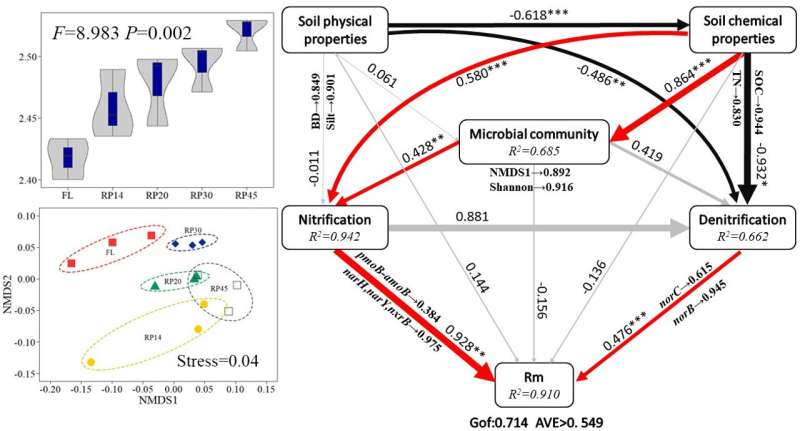This article has been reviewed according to Science X's editorial process and policies. Editors have highlighted the following attributes while ensuring the content's credibility:
fact-checked
proofread
Study uncovers the role of soil microbes in forest ecosystems

Assessing the function of forest ecosystems requires a deep understanding of the mechanisms of soil nitrogen mineralization. A study conducted by a team of researchers has shed light on how soil N-cycling genes drive soil nitrogen mineralization during afforestation.
The findings, published in Soil Ecology Letters, provide valuable insights into the relationship between soil microbial communities, functional genes, and the rate of soil nitrogen mineralization.
The researchers collected soil samples from a chronosequence of Robinia pseudoacacia L (RP14, RP20, RP30, and RP45) at different stages of afforestation, along with a sloped farmland (FL) as a control. Metagenomic sequencing analysis revealed significant changes in the diversity and composition of soil microbial communities involved in N-cycling as the forestation progressed. Afforestation was found to effectively increase the diversity of soil microbial communities.
To further investigate the relationship between soil microbial communities and nitrogen mineralization, the researchers conducted indoor culture experiments and analyzed correlations.
The results showed a significant increase in both soil nitrification rate (Rn) and soil nitrogen mineralization rate (Rm) with increasing stand age. The study also found a strong correlation between soil Rm and soil microbial diversity as well as the abundance of soil N-cycling genes.
Using partial least squares path modeling (PLS-PM) analysis, the researchers discovered that nitrification and denitrification genes had a greater direct effect on soil Rm than soil microbial communities. This suggests that functional genes related to soil nitrogen cycling play a crucial role in driving soil nitrogen mineralization during afforestation.
The study was conducted on the Loess Plateau, an important region for afforestation efforts. The findings provide a better understanding of the effects of microorganisms on soil nitrogen mineralization rate during afforestation and offer a new theoretical basis for evaluating soil nitrogen mineralization mechanisms during forest succession.
"These findings have important implications for forest management and ecosystem restoration," said Professor Ren, the lead author of the study. "By understanding the role of soil microbes and functional genes in soil nitrogen mineralization, we can optimize afforestation practices and enhance the ecological functions of forest ecosystems."
The research team hopes that these findings will contribute to the development of more sustainable and effective forest management strategies, especially in regions undergoing afforestation efforts.
By considering the role of soil microbes and functional genes, forest restoration projects can be designed to maximize the benefits to both the environment and society.
More information: Yaping Zhao et al, N-cycle gene abundance determination of N mineralization rate following re-afforestation in the Loess Plateau of China, Soil Ecology Letters (2024). DOI: 10.1007/s42832-023-0188-0
Provided by Higher Education Press




















